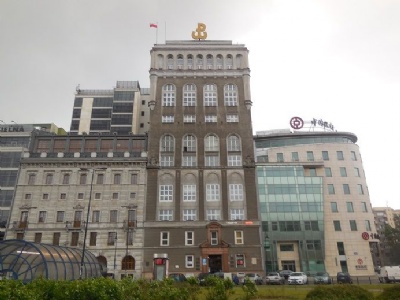Warsaw Uprising
In the summer of 1944, the Soviet Red army approached Warsaw and the polish home army (Armia Krajowa) saw an opportunity to attack the germans in the rear while the russians attacked. The uprising started on August 1, 1944, and initially reaped successes, attacking the Germans in the rear, barricading themselves among houses, bunkers and sewers, collecting all kinds of weapons wherever it could be find. Fierce battles were fought in buildings such as PAST and Prudential. The home army didn’t not only consist of men but also of women and children.
But the Polish home army success relied on the Soviet Red Army coming to the rescue. When this didn’t happen the home army’s was doomed as it didn’t had the resources to defeat the germans all by themselves. Although western allies were able to supply the home army with supplies from the air. but this easn’t enough. The German defence was led by SS-Obergruppenführer, Erich von dem Bach-Zewelski, and consisted of a motley crew of SS units, police units and anti-partisan units. The units crushed the uprising with enormous brutality, both against civilians and soldiers from the home army, and committed merciless massacres in districts of Ochota and Wola to name a couple.
Despite the appeal to Stalin from both the Polish government in exile in London and the British prime minister, Winston Churchill, to come to the home army’s assistance, but Stalin ignored this (even the support of the western powers was severely limited). The Germans could therefore deploy all available resources to the fighting against the insurgents and crush them methodically til the bitter end, October 3, 1944, when they surrendered.
From a wider perspective, the news of the uprising from the three great allies (USA, Britain and the Soviet Union) was met with restraint and no excessive joy. The uprising came as no surprise, but had been going on for a long time, but once it broke out, it was on local initiative and was not sanctioned by either the Polish government of exile in London, the western powers or the Soviet Union. The uprising therefore caused political, military and diplomatic problems among USA, Britain and Soviet Union. Polish and Soviet relations were extremely strained ever since the Soviet invasion of Poland in mid-September 1939.
The discovery of the mass graves in Katyn in March 1943, where the Soviet Security Service (NKVD) murdered polish officers in March 1940, didn’t make things easier. In addition, both the Polish home army and the Polish government of exile in London were in Stalin’s eyes illegitimate. From an American perspective, the uprising was of little importance and their approach was more from a global perspective. A local uprising was a minor issue and for USA it was important not to jeopardise relations with the Soviet Union. The British were more or less politically and diplomatically bound and well aware that their ability to influence Stalin was non-existent. And from the Polish side they had absolutely nothing to say about and were completely omitted to Stalin’s benevolence.
Current status: Rebuilt with museum/monument (2015).
Location: 52°14'58" N, 21°0'21" E
Get there: Car, Tram or Bus.
Follow up in books: Davies, Norman: Rising ’44: The Battle for Warsaw (2004).















The monuments are scattered all over Warsaw and are most easily reached by car. In the post-communist description of history, the insurgents and their leaders were described as bandits and fascists who were in fact a threat to Poland. Leading insurgents were arrested, imprisoned, deported, tortured and even murdered by the Communists. No books, films, monuments, memorials or anything else that could nourish Polish nationalism were to be considered. This eased somewhat in the years after Stalin’s death, but it was only when communism began to crack in the early eighties that censorship was loosened. Even in the Western description of history, the insurrection was marginalized, more perhaps on a shameful account of having omitted an ally in distress than it would have been illegitimate. Only after the fall of communism the uprising, in both the west and the east, been revised and finally got the recognition that it has been denied for almost 45 years.